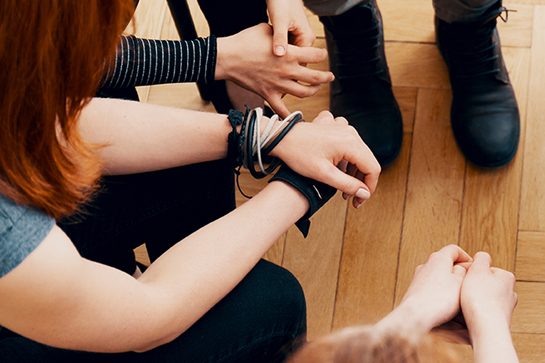The month of September represents National Suicide Prevention and Awareness Month. Each year in the United States more than 41,000 individuals die by suicide. Although suicide occurs in all segments of society, three groups are particularly vulnerable: runaway homeless youth, veterans, and the elderly. Often, individuals in these categories struggle with a variety of conditions, including poor mental health, behavioral disorders, homelessness, and substance use disorders, making them even more susceptible. It can appear to be an endless cycle of despair.
Fortunately, there is good news. Organizations and communities all over the country are coming together to help prevent suicide by addressing all aspects of health for vulnerable individuals. Because of the many different emotional, physical, and social factors that contribute to suicide, having a full picture of an individual’s health makes all the difference. In honor of National Suicide Prevention and Awareness Month, we are going to discuss the needs of these populations, the programs and services that are available, and highlight the organizations making a difference in preventing suicide in their communities.
Runaway Homeless Youth
A large percentage of this population belong to the LGBTQ community. Once homeless, LGBTQ youth are more susceptible to mental health issues, substance abuse, risky behavior and, consequently, are at an increased risk of committing suicide.
The National Coalition for the Homeless and National Gay and Lesbian Taskforce Policy Institute has laid out guidelines and government programs dedicated to help these at-risk youth. Programs like the Street Outreach program provide supports and services such as:
- Street-based education
- Access to emergency shelter
- Individual assessments
- Treatment and counseling
- Prevention and education activities
- Information and referrals
- Crisis intervention
- Follow-up support
Making a Difference
We would like to give a shout out to one of our clients, the Los Angeles Youth Network, for their creative efforts in resolving this crisis. Los Angeles Youth Network’s Mental Health Department provides comprehensive mental health services, including family counseling, substance abuse counseling, programs to develop coping skills, and more.
Veterans
As of 2014 an average of 20 Veterans died from suicide each day. Veterans have an increased likelihood of becoming homeless and often suffer from substance use disorder due to the stress of transitioning from active service back into regular society.
The Department of Veteran Affairs (VA) is aggressively pursuing new measures for preventive care for Veterans who are at risk of suicide, including:
- Veterans Crisis Line: Provides immediate access to mental health crisis intervention and support, including chatting/texting.
- Using predictive analytics to identify at-risk individuals
- Expanding mental health services for the growing population of women veterans
- Free mobile apps to help veterans and their families by providing them with the tools to help manage emotional behavioral concerns such as, post-traumatic stress disorder (PTSD), insomnia, and depression
- Expansion of public and private partnerships to help reach Veterans and provide access to timely mental health care.
Making a Difference
The National Veteran Homeless Support, was founded by veterans to eliminate homelessness among veterans. They work with a network of community partners, including community leaders, businesses, and law information to provide transitional housing. They also provide support services, including a PTSD program and a search and rescue program that reaches out to homeless Veterans.
Elderly
Seniors are often not mentioned when discussing suicide, but statistics from the Centers for Disease Control indicate that seniors cannot be overlooked. It is estimated by the U.S. Census Bureau that between 2012 and 2050 the number of Americans over the age of 65 will almost double in size from 43.1 million to 83.7 million. Seniors deal with a specific set of issues that promote suicidal thoughts such as failing health, loss of loved ones, and burdens related to autonomy. In 2013 more than 7,000 people 65 and older died by suicide. According to Chris Mirara, senior project director for the SAMHSA-funded Suicide Prevention Resource Center, depression is not a normal part of aging. There are ways to help prevent our elderly population from falling into despair.
The Substance Abuse and Mental Health Services Administration has provided a new resource, Promoting Emotion Health and Preventing Suicide, to help older adults address the behavioral health concerns contributing to suicide. It addresses 3 strategies to ensuring good mental health among seniors.
- Strategy 1: Promote Emotional Health
- Offer activities and programs that promote purpose and encourage social connections
- Provide activities that integrate mental and physical health
- Strategy 2: Recognize and Respond to Suicide Risk
- Understand the warning signs
- Recognize and respond to depression
- Recognize and respond to Medication and Alcohol misuse
- Increase access to care
- Strategy 3: Respond to a Suicide Attempt or Death
- Develop post intervention for responding to a suicide attempt or death
Making a Difference
Jewish Family Services of Colorado offers a wide range of programs and senior care services that encourage older adults to stay active, healthy and independent. The JFS care managers have advanced degrees in gerontology and work with clients to create a proactive care plan that addresses their emotional and physical needs, thus enabling them to stay connected.
Conclusion
Suicide Prevention and Awareness Month gives everyone the opportunity to discuss and share resources in search of better solutions when caring for those at-risk for suicide. We are proud to work with the organizations highlighted here to support their efforts to provide access to preventative care to ensure the well-being of these individuals. They are just a few of many similar organizations across the nation.
Blog Resources
https://www.nami.org/Get-Involved/Awareness-Events/Suicide-Prevention-Awareness-Month



